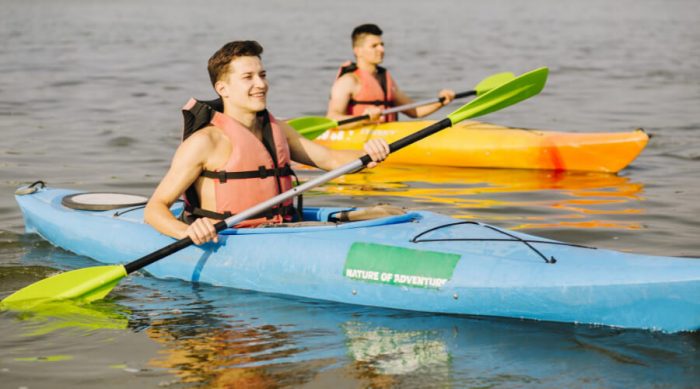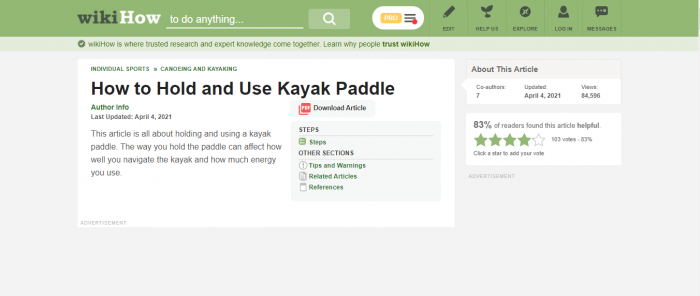According to many kayak professionals, you should pick a kayak paddle that is about 6-8 inches longer than your height. Apart from that, there are quite a few factors that you have to consider while buying a kayak paddle like the weight of the kayak, type of the kayak, height of the paddler, etc.
Key Takeaways
- The energy that you will use during kayaking will highly depend on your kayak paddle size
- The length of the paddle will depend on your personal build and kayak width
- If your torso is more prolonged then you will need a longer paddle
- The diameter of a paddle shaft depends on the size of your hands; if your hand is small then you will need a smaller shaft diameter while a big shaft diameter is best for big hands
What Size Kayak Paddle Do I Need?

Look at the following kayak paddle sizing chart to choose the ideal length:
Kayak Paddle Size Chart
| Height of the paddler | Width of the kayak | |||
| Under 23² | 23² to 27.9² | 28² to 32² | Over 32² | |
| Under 5¢ | 200 cm | 210 cm | 220 cm | 230 cm |
| 5¢to 5¢6² | 210 cm | 220 cm | 230 cm | 240 cm |
| 5¢7² to 6¢ | 220 cm | 220 cm | 230 cm | 240 cm |
| Over 6¢ | 220 cm | 230 cm | 240 cm | 250 cm |
The ideal paddle is a very crucial element to consider if you want to have a pleasant day on the water. The energy that you will use during kayaking will highly depend on your kayak paddle size. For example, if you decide to use a paddle that is very short or excessively elongated, you will overwork yourself to create the necessary momentum and maintain the kayak on the pathway. Also, a long shaft will blister your hands and make you very exhausted.
Paddle Length
The paddle length will depend on your personal build and kayak width.
1. Personal Build
The height of your body will not influence the paddle size that you want. However, the size of your torso length will manipulate the distance between the water and you in the kayak. For example, if your torso is more prolonged, your paddle should be longer to gather for the distance added. Advisedly, you should sit in your kayak while measuring your upper body, to know the distance from your nose to the top of the seat.
2. Kayak Width
The kayak size you choose should be based on the anticipated use. For example, kayak for entertainment and fishing tends to be wider to enable their strength and stability while kayak for fast-moving tours is narrow for improved paddling performance. The wider the kayak, the longer paddle you’re going to need.
Paddle Shaft Diameter
The diameter of a paddle shaft you pick will depend on the size of your hands. For example, if your hands are small, select a smaller shaft diameter. Consequently, it would be best if you went for a kayak that fits well in your hands to avoid blistering your hands as well as overworking yourself. You should also consider using paddle gloves on your kayak trips because if your hands are wet and you are paddling without gloves, you will develop blisters.
1. Bent Paddle Shaft
The kayak with a curved design enables comfort and efficiency by offering additional contact between the paddle and your hand, therefore reducing the unnecessary movements of the paddle when in hand.
How To Choose Kayak Paddles?

The paddle that you opt for will affect the performance you will have on the water. Therefore, you go for an excellent paddle if you want to have an enjoyable kayaking trip. For you to choose the right kayak paddle, consider the following factors:
1. Length
2. Materials
3. Blade design
4. Shaft design
Length
The boat’s height and width will influence the length of the paddle. Choosing the ideal length size is very easy since; if your boat is wider, choose a longer paddle and vice versa. Also, the height of your body will determine the length of the paddle; if you are tall, then you will need to go for longer paddles and vice versa.
Besides, choose a tweener size that is shorter because it will enable you to save a few ounces. Also, if you want to use your paddle for leisure in flat water, then the low and high-angle paddles are ideal for you.
Materials
The materials used in manufacturing a kayak are lightweight to improve the performance of your boat, though it adds to the paddle price.
1. Blade Materials
Diverse blade materials differ in the transfer of energy to your strokes. For example, if you raise your blade high than your shaft, you will not get tired easily because of the lightweight materials.
Plastic blades
You should go for plastic blades if you want to use them for recreational purposes since they are low in price. However, you should not expose these plastic materials to the sun to prevent them from fracturing.
Fiberglass blades
The blades made from fiberglass are long-lasting, give you better performance, and are not expensive to acquire. Though they are lightweight, they may fragment but not fracture as compared to plastic. Purposely, go for stiff blades made from fiberglass since; they are proficient in water.
Carbon fiber blades
You should go for carbon-fiber blades if you are not financially limited because they offer top performance. This material is ultra-light and ultra-stiff for exceptional transfer of energy with each stroke.
2. Shaft materials
Aluminum is a shaft material that is durable, serviceable, and wallet-friendly; therefore, it is worth it for you to purchase. On the other hand, you should go for carbon and fiberglass shafts that are sturdy, lightweight, and long-lasting.
Moreover, if you pair carbon and fiberglass beam resources with whichever of the above, not massive blade resources, you will have the most not substantial and capable paddle option.
Blade Design
The blade paddle shape and size will influence the general competence of the boat in the water. Nowadays, the paddle blades come in an asymmetrical dihedral shape, which is moderately short and thin on one side. This shape angles it to create a uniform float-up of the blade in the water.
Moreover, your blade can be marked using the shred down its center to permit the water to flow easily and uniformly over individual halves of the blade. However, the blades are devoid of this flap more, thus making it very difficult to trail straight.
Furthermore, narrow blades are efficient for a whole day or multi-day tour since it enables lengthy paddling stretches. Besides, wider blades perform strokes rapidly, thus facilitating you to pick up the pace quickly. Also, other particular blades for fishing come in J-shaped indentations in the blade to get back trapped fishing tackles.
Shaft Design
The paddle shafts are very crucial when choosing a paddle since it permits you to spin them to be matched. A rod can be bent or straight, depending on your needs. Bent tube paddles eliminate fatigue in the joints and provide more comfort to your hands, thus progressing the paddling efficiency.
Furthermore, the shaft comes in four or two-piece, made to give out a more accessible storeroom. Also, four-piece shaft models have shorter segments; therefore, well, if you are thinking about going for a hike with a portable kayak. Apart from these, shafts also come in small diameters, thus offering a less tiring grip for you if you have small hands.
How To Use And Hold A Kayak Paddle?

The way you hold and use the paddle will affect the energy you use and how you navigate the boat. Below are the steps to follow when holding and using the paddle in your boat.
Step 1: Familiarize yourself with the structure of the kayak paddle since; it has two blades close to the paddle shaft. During kayaking exercises, the propel part that you hold is a shaft, and the part that offers you support when pulling is the blade.
Step 2: You should hold the paddle 40 cm apart using both hands.
Step 3: Ensure that your paddle faces the right direction because many beginners tend to make a mistake in which direction the boat is moving when kayaking.
Step 4: Since many paddles are asymmetrical, you should ensure that the paddle is right to be right side up.; the paddle blade has a bottom and topside. Also, the design of the paddle determines how you hold it since the propel top is more horizontal than its base. Moreover, some paddles have even writing on the paddle to remind you of how to keep the paddle appropriately.
Step 5: You should ensure that the blade is in line with your knuckles.
Step 6: Next, ensure that your body is 30 cm away when holding the proper.
Step 7: You should be well conversant with your grip control. For example, your control grip will be held by your right hand if you are right-handed. Still, your control grips will be held by your left hand if you are left-handed. Also, when paddling, let the paddle revolve and change position in your hand to facilitate each paddle in entering the water effortlessly.
Step 8: Finally, when kayaking, your paddle should be firmly pushed to enable you to go more quickly and prevent it from going too deep.
Proper Technique For Paddling A Kayak
Final Thought
While choosing and purchasing a kayak paddle, you need to put in mind that the main goal is comfort when paddling your kayak. In the market, there are many kayak paddles; therefore, pick one that meets your desires to ensure that you have a pleasant day on the water.
References:
- https://www.ez-dock.com/blog/kayak-paddle-size-guide/
- https://aquabound.com/pages/kayak-paddle-sizing-guide

Rockey is a kayaking enthusiast who has been kayaking with a local group for the last five years. He loves using kayaks while out on outings on the water or camping when the friends want to have a BBQ party somewhere on the bank of a local lake. More About James R Rockey at About Page Here: Authors
Based on his experiences with the different types of kayaks, he is sharing his opinion about kayaking tricks and required gears so that a beginner can get started right away.
Find his team on Twitter here. Happy reading!
